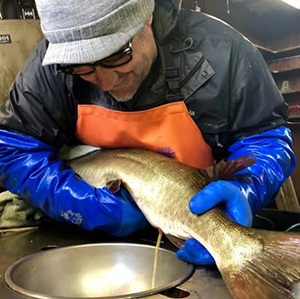By Louie Stout
 Indiana’s Webster Lake Produces Record Number of Muskies, EggsIf last week’s annual collection of Webster Lake muskie eggs is any indication, the future is bright.
Indiana’s Webster Lake Produces Record Number of Muskies, EggsIf last week’s annual collection of Webster Lake muskie eggs is any indication, the future is bright.
I mean, really bright.
“It’s the best year of capturing adult muskies we’ve ever had,” said a jubilant Jed Pearson, Indiana DNR fisheries biologist who manages Webster. “We have a lot of muskies out there.”
In one week’s work of setting and checking traps, fish managers collected 305 muskies that produced 890,000 eggs.
The fish were stripped of eggs and fertilized by hand on shore then immediately released back in the lake. The eggs were taken to Fawn River Hatchery and later will be transported to the East Fork Hatchery in southern Indiana.
The eggs will hatch and the young moved to outdoor ponds before shipped back to Webster to be stocked this fall as 8 to 10 inchers and some again next spring as 12 to 13 inchers.
Indeed, the bulk of the fish Pearson and the Fawn River Hatchery team handled were sub-legal; most ranged in size from 30 to 35 inches (3- to 4-year old fish). Pearson said 18 were 40 inches or more and only two were legal-size (44 inches at Webster; 36 at other lakes).
While the lack of trophy fish may seem disappointing, the number of adult fish is definitely good news for a muskie lake that was once the Midwest’s crown jewel before collapsing a few year ago.
For example, in 2016, the DNR managed to collect only 42 adult muskie for brood stock and had to work hard for those.
The crash was due largely to the lake association’s overzealous chemical treatment of aquatic vegetation, which has since been rectified, and a change in stocking practices, which also has been altered to provide bigger fish for better survival.
In 2017 biologists gathered 88 fish and that number jumped to 126 last year before more than doubling this year.
“I really believe our efforts of planting bigger fish in the spring are paying off,” said Pearson. “A big percentage of the fish we caught this year had tags we planted on them. We know this stocking effort is being more successful than what we were doing several years ago.”
Pearson said Webster was down to about 500 fish a few years ago and his rough estimate today is between 1,500-2,000 adult muskies.
Could that be too many?
Quite possibly, said Pearson. He has concerns that there may be too many in the lake and may require some stocking number cutbacks. As of right now, specific changes aren’t being discussed.
“We don’t want to get in a situation where we have so many muskies that we get slower growth or the adults start cannibalizing the young ones we stock each year,” he said. “It’s something we have to look at.”
Last week’s netting turned up at least two muskies netted that were used for egg taking in previous years and again this year.
“We had one muskie we’ve caught seven times since 2011 and one female we caught in 2005,” said Pearson. “The largest fish we caught this year (45 inches) we netted in 2005 in the backwaters when she was 31 inches. We never saw her for until this year (14 years later). She grew 14 inches longer and I suspect that makes her about 17 to 18 years old. This year, we caught her along the north shore of the main lake.”
Pearson said the trap nets at the lake also captured several nice crappie, bluegill and legal bass, all of which were released.


